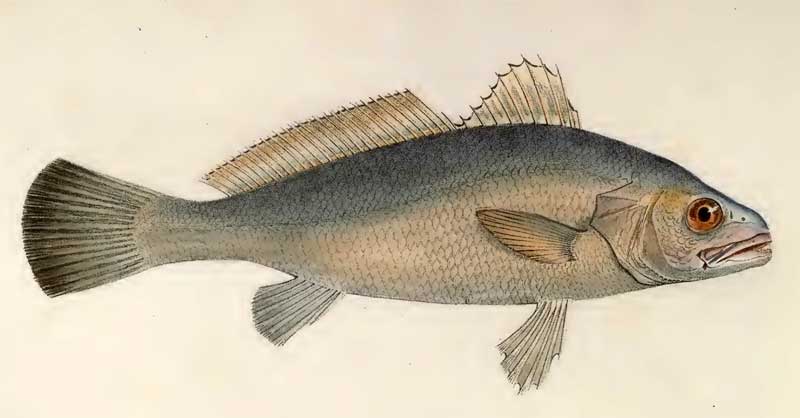
Superregnum: Eukaryota
Cladus: Unikonta
Cladus: Opisthokonta
Cladus: Holozoa
Regnum: Animalia
Subregnum: Eumetazoa
Cladus: Bilateria
Cladus: Nephrozoa
Superphylum: Deuterostomia
Phylum: Chordata
Subphylum: Vertebrata
Infraphylum: Gnathostomata
Megaclassis: Osteichthyes
Superclassis/Classis: Actinopterygii
Classis/Subclassis: Actinopteri
Subclassis/Infraclassis: Neopterygii
Infraclassis: Teleostei
Megacohors: Osteoglossocephalai
Supercohors: Clupeocephala
Cohors: Euteleosteomorpha
Subcohors: Neoteleostei
Infracohors: Eurypterygia
Sectio: Ctenosquamata
Subsectio: Acanthomorphata
Divisio/Superordo: Acanthopterygii
Subdivisio: Percomorphaceae
Series: Eupercaria
Ordo: Perciformes
Subordo: Percoidei
Superfamilia: Percoidea
Familia: Sciaenidae
Genus: Sciaena
Species: Sciaena umbra
Name
Sciaena umbra Linnaeus, 1758
Synonyms
Bairdiella umbra, (Linnaeus, 1758)
Coracinus chalcis, (Pallas, 1814)
Corvina canariensis, (Cuvier, 1830)
Corvina nigra, misapplied name
Corvina umbra, (Linnaeus, 1758)
Johnius nigra, misapplied name
Johnius umbra, (Linnaeus, 1758)
Sciaena nigra, (Bloch, 1792)
References
Linnaeus, C. 1758. Systema Naturae per regna tria naturæ, secundum classes, ordines, genera, species, cum characteribus, differentiis, synonymis, locis, Tomus I. Editio decima, reformata. Holmiæ: impensis direct. Laurentii Salvii. i–ii, 1–824 pp DOI: 10.5962/bhl.title.542: 289. Reference page.
Picciulin, M., Bolgan, M., Corò, A. B., Calcagno, G. & Malavasi, S. 2016. Sound production by the Shi drum Umbrina cirrosa and comparison with the brown meagre Sciaena umbra: a passive acoustic monitoring perspective. Journal of Fish Biology, Article first published online: 8 MAR 2016. DOI: 10.1111/jfb.12926Reference page.
Links
Sciaena umbra in the World Register of Marine Species
Vernacular names
català: Corball de roca
Deutsch: Meerrabe
English: Brown meagre
français: Corb
hrvatski: Kavala
italiano: Corvina
Nederlands: Zwarte ombervis
tarandíne: Curvìedde
srpskohrvatski / српскохрватски: Kavala
slovenščina: Kaval
svenska: Korpfisk
Türkçe: Eşkina
українська: Горбань темний
中文: 弓背石首魚
Brown meagre or corb (Sciaena umbra) is a species of croaker found in, the eastern Atlantic, Mediterranean Sea and Black Sea occurring in shallow waters and sandy bottoms. It is harvested for human consumption, especially in the Mediterranean.
Etymology
The specific name umbra is derived from the Latin for a shadow or phantom[3] while the generic name is derived from the Greek skiaina or skion meaning a fish, or more specifically a red mullet.[2]
Distribution
The brown meagre is found in the eastern Atlantic Ocean from the southern English Channel south to Senegal and Cape Verde, including the Canary Islands,[4] records from West Africa south of Senegal are questionable. Also in the Mediterranean Sea, the Black Sea[1] and Sea of Azov.[4]
Habitat
Corbs (Sciaena umbra) from Ligurian sea
The brown meagre is found at depths between 5m and 200m,[5] mainly over rocky and sandy substrates and the young enter estuarine environments.[6]
Description
The brown meagre is between 30 and 40 cm in length but can grow to 60 cm. It has a flat belly and its strongly arched back which give it an easily recognisable shape, the body is laterally compressed and the large, horizontal mouth reaches the level of the eye and contains villiform teeth. The anal and pelvic fins are black with an anterior white border. Both dorsal fins and the truncate caudal fin, are yellow with a black border. The body is grey with flashes of gold and silver. The scales are ctenoid on the nape and the body while the head scales are cycloid.[5][4]
Biology and behaviour
Sciaena umbra juvenile
It is a rather nocturnal fish but it can occasionally be found during the day among beds of sea grass and on rocky bottoms in the vicinity of caves or large crevices where it can shelter. This species is social and lives in small groups.[6] It feeds off the small fishes and crustaceans. They are capable of creating sound using some muscles under their well developed swim bladder. This is their way of communication since they have a very good hearing ability.[7] They can manage their buoyancy perfectly.[2] The spawning period is from March to August in the Mediterranean.[4]
Fisheries
The brown meagre is a commercial species throughout the Mediterranean basin and has been over exploited by fishing practices. It is fished mainly by spear fishing, trammel nets, and gill nets and is heavily exposed to fisheries during spawning aggregations at the mouths of estuaries.[6]
Sold fresh or frozen across fish markets in Turkey. The otoliths of the brown meagre are ground and used for urinary infections by local people in Turkey.[2] The sport and commercial fishing of this species was banned in Turkey until 2003 and 2006 to help conserve the stock.[6]
References
Chao, L. (2020). "Sciaena umbra". IUCN Red List of Threatened Species. 2020: e.T198707A130230194. doi:10.2305/IUCN.UK.2020-2.RLTS.T198707A130230194.en. Retrieved 12 November 2021.
"Sciaena umbra Linnaeus, 1758". Fishbase.org. Retrieved 27 December 2016.
"Umbrina cirrosa (Linnaeus, 1758)". Fishbase.org. Retrieved 27 December 2016.
"Fishes of the NE Atlantic and Mediterranean - Browm Meagre (Sciaena umbra)". Marine Species Identification Portal. ETI BioInformatics. Retrieved 27 December 2016.
"Sciaena umbra". Association Mer et Littoral. Retrieved 27 December 2016.
"Scaiena umbra". IUCN Red List of Threatened Species. Retrieved 27 December 2016.
M. Picciulin; M. Bolgan; A.B. Corò; G. Calcagno; S. Malavasi (2016). "Sound production by the Shi drum Umbrina cirrosa and comparison with the brown meagre Sciaena umbra: a passive acoustic monitoring perspective". Journal of Fish Biology. 88 (4): 1655–1660. doi:10.1111/jfb.12926.
Retrieved from "http://en.wikipedia.org/"
All text is available under the terms of the GNU Free Documentation License

